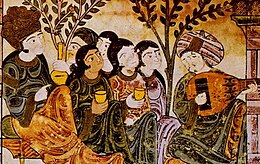Arab Muslims
العرب المسلمون | |
|---|---|
 Population of Arab Muslims | |
| Regions with significant populations | |
| Vast majority of the population | |
| Languages | |
| Arabic | |
| Religion | |
| Sunni Islam (majority) Shia Islam (minority) |
| Part of a series on |
| Arabic culture |
|---|
 |
Arab Muslims (Arabic: العرب المسلمون) are adherents of Islam who identify linguistically, culturally, and genealogically as Arabs. Arab Muslims greatly outnumber other ethnoreligious groups in the Middle East and North Africa. Arab Muslims comprise a majority of the population of the Arab World.[1] Not all citizens of Arab-Muslim majority countries identify as Arab Muslims; many Arabs are non-Muslim and many Muslims are of non-Arab ethnicity. As of 2010, Muslims constitute 93% of the region’s population, followed by Christians, who comprise approximately 4% of the MENA population. Jews also live in the region, and they constitute 2% of the population. Hindus and unaffiliated individuals make up the remaining 1% of the MENA region population.[2] Arab Muslims form the largest ethnic group among Muslims in the world,[3] followed by Bengalis,[4] and Punjabis.[5]
A substantial number of Arab Muslims live outside their countries of origin. Arab Muslims comprise the majority of the Arab populations in Belgium, France, Germany, Indonesia, Iran, Israel, the Netherlands, Turkey, and the United Kingdom, while Arab Christians are the majority of the Arab populations in Argentina, Australia, Brazil, Chile, Colombia, Cuba, Greece, Haiti, Mexico, the United States, Uruguay, and Venezuela. Around a quarter of Arab Americans identify as Arab Muslims.[6]
Arab Muslims in North Africa
North Africa is a geographical area that constitutes Morocco, Tunisia, Algeria, Mauritania, Libya, Egypt, Sudan, and the western Sahara. Some refer to North Africa as the “Maghreb”, or the “west”, though the Maghreb only comprises Algeria, Morocco, Tunisia, Mauritania, and Libya.[7] Arabic is the main language of the region, though each country has its own dialect of both Beber- Tamazight languages- and Arabic.[8] Sunni Islam is the region’s main religion, and the Maliki Madhhab is the main Islamic school of thought followed by North Africans.[9] The vast majority of North Africans identify as Arabs or Arab Muslims. Therefore, North Africans perceive themselves as part of the Mediterranean and the Middle East rather than Africa where they are geographically located. [10]
The spread of Islam and Arab civilization in North Africa
Before the Islamic conquest took place, North Africa was mainly inhabited by the Berbers (native inhabitants of North Africa), also locally called the Amazigh which means free man and woman. [11]The Amazigh were Animists until Islam reached north Africa and they were thus coerced into converting to Islam[12] in a process known as the Arabisation and Islamization of the Berbers. Arabization refers to the process of acculturation in which the people of north Africa adopt the Arabic language in addition to various other aspects of Arabic culture. This consequently made North Africans move from being Berbers to being Arabs. Islamization on the other hand refers to the process by which North Africans converted to Islam and thus became Muslims by faith. Though the majority of north Africans identify as Arabs today, a number of the population still perceive themselves as merely Berbers.[13]
Islam initially started in the middle east in the Arab peninsula in the 600’s CE but quickly spread to coastal north Africa through coerced military conquest- following the death of prophet Mohammed in 632 C.E-. Arabs aimed at geographically expanding their empire. They started conquering North Africa in 647 CE and by 709 EC, all of North Africa was under the control of Arabs and Muslim rule from Egypt to Morocco [14]. North Africa was then divided into three main areas. Egypt with its governor center being Al-Fustat. Ifriqiya (modern-day Tunisia) with its governor center being Kairouan and the Maghreb (modern-day Algeria and Morocco) with its governor center being Fez. [15]
During the 7th century, north Africa experienced three distinct invasions leading to the establishment of not only a new religion (Islam) but also a new language and norms that differed significantly from what was established by the indigenous inhabitants, the Amazigh.[16]
See also
References
- ^ Peter Haggett (2001). Encyclopedia of World Geography. Vol. 1. Marshall Cavendish. p. 2122. ISBN 0-7614-7289-4.
- ^ "Middle East-North Africa". Pew-Templeton: Global Religious Futures Project.
- ^ Margaret Kleffner Nydell Understanding Arabs: A Guide For Modern Times, Intercultural Press, 2005, ISBN 1931930252, page xxiii, 14
- ^ roughly 152 million Bengali Muslims in Bangladesh and 36.4 million Bengali Muslims in the Republic of India (CIA Factbook 2014 estimates, numbers subject to rapid population growth); about 10 million Bangladeshis in the Middle East, 1 million Bengalis in Pakistan, 5 million British Bangladeshi.
- ^ Gandhi, Rajmohan (2013). Punjab: A History from Aurangzeb to Mountbatten. New Delhi, India, Urbana, Illinois: Aleph Book Company. p. 1. ISBN 978-93-83064-41-0..
- ^ "Arab Americans: Demographics". Arab American Institute. 2006. Archived from the original on 1 June 2006. Retrieved 22 August 2020.
- ^ "Political Map of North Africa, the Middle East, and the Arabian Peninsula". Nations Online Project.
- ^ "What Languages Are Spoken In Africa?". World Atlas.
- ^ "Islam: Islam in North Africa". Encyclopedia.
- ^ "How 'African' is Northern Africa?". Global Voices.
- ^ Budjaj, Aymane; Benítez, Guillermo; Pleguezuelos, Juan Manuel (2021). "Ethnozoology among the Berbers: pre-Islamic practices survive in the Rif (northwestern Africa)". Journal of Ethnobiology and Ethnomedicine.
- ^ Cartwright, Mark. "The Spread of Islam in Ancient Africa". World History Encyclopedia.
- ^ Kokole, Omari H (1984). "The Islamic Factor in African-Arab Relations". Third World Quarterly. 6 (3): 687–702.
- ^ Gharba, Mahdi. "A BRIEF HISTORY OF ISLAM IN NORTH AFRICA". The Muslim Vibe.
- ^ Chakra, Hayden. "Arab Conquest of North Africa". About History.
- ^ Gearon, Eamonn. "Arab Invasions: The First Islamic Empire". History Today.
Bibliography
- Ankerl, Guy (2000). Coexisting Contemporary Civilizations: Arabo-Muslim, Bharati, Chinese, and Western. Geneva: INU Press. ISBN 2-88155-004-5.